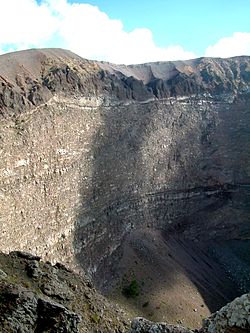Volcanic crater
Volcanic craters are circular depressions caused by volcanic activity. They function as the opening or eruption mouth of many volcanoes and are generally located on their tops.
During volcanic eruptions, magma and volcanic gases rise from an underground magma chamber, through a tube-shaped conduit, until they reach the crater opening, from where the gases escape into the atmosphere and the magma erupts as lava. A volcanic crater can be large and sometimes very deep. During certain types of explosive eruptions, a volcano's magma chamber can empty enough that an area above it subsides, forming a larger type of depression known as a caldera.
Features
The crater usually takes the shape of an inverted cone on top of a mountain formed by erupting volcanic deposits such as lava flows and tephra. Sometimes it is located on a flank, when it has an adventitious cone, and then the crater is classified as lateral or parasite. It can also happen that the volcano lacks a cone, like Hawaiian-type volcanoes, and then the crater is a cavity in the ground in which lava bubbles and churns, overflowing during eruptions.
There are volcanoes that, depending on their origin, can contain more than one crater, but always a main one. These craters can have different dimensions from a few meters to kilometers.
Some volcanic craters can be partially or completely filled with rain and/or snowmelt, forming a crater lake.
A crater can be ruptured during an eruption, either by explosions or by lava or subsequent erosion. Drilled craters have a much lower rim on one side.
Some volcanoes, like Maars, consist of a single crater, with hardly any mountains. These volcanic explosion craters form when magma rises through water-saturated rock, causing a phreatic eruption. Volcanic craters from phreatic eruptions often occur on plains far from other obvious volcanoes. Not all volcanoes form craters.

